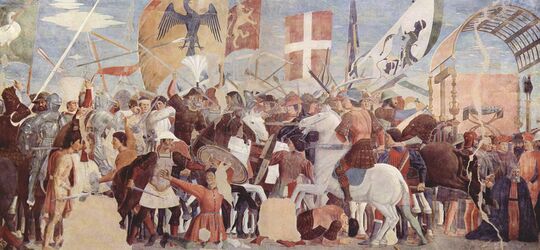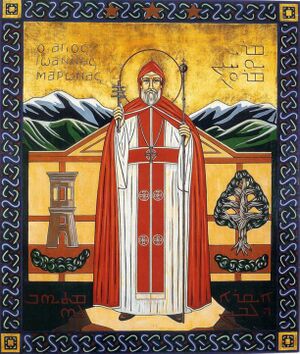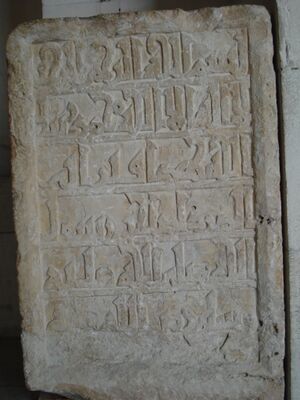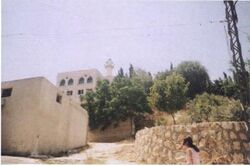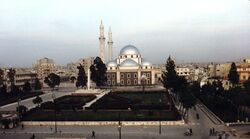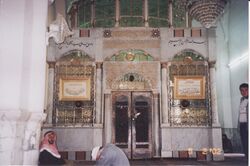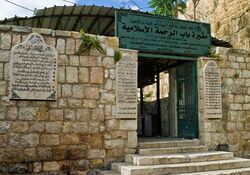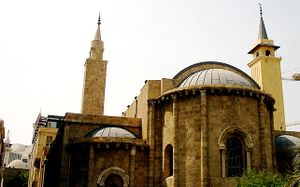القرن السابع في لبنان
| القرن السابع في لبنان |
| Key event(s): |
| Chronology: |
|

هذا المقال هو جزء من سلسلة عن: | |||
| التاريخ القديم | |||
| تاريخ لبنان | |||
| فينيقيا | |||
| التاريخ القديم للبنان | |||
| الحكم الأجنبي | |||
| الحكم المصري | |||
| الحكم الآشوري | |||
| الحكم البابلي | |||
| الحكم الفارسي | |||
| الحكم اليوناني | |||
| الحكم الروماني | |||
| الحكم البيزنطي | |||
| الحكم العربي | |||
| الحكم العثماني | |||
| الحكم الفرنسي | |||
| لبنان المعاصر | |||
| أزمة لبنان 1958 | |||
| الحرب الأهلية اللبنانية | |||
| حرب لبنان 1982 | |||
| السيطرة السورية على لبنان | |||
| تفجيرات لبنان 2005 | |||
| ثورة الأرز | |||
| حرب لبنان 2006 | |||
| الاحتجاجات السياسية 2006-8 | |||
| صراع شمال لبنان 2007 | |||
| الصراع في لبنان 2008 | |||
| حسب المواضيع | |||
| التاريخ العسكري | |||
| التاريخ الاقتصادي | |||
| خط زمني للتاريخ اللبناني | |||
This article lists historical events that occurred between 601–700 in modern-day Lebanon or regarding its people.
. . . . . . . . . . . . . . . . . . . . . . . . . . . . . . . . . . . . . . . . . . . . . . . . . . . . . . . . . . . . . . . . . . . . . . . . . . . . . . . . . . . . . . . . . . . . . . . . . . . . . . . . . . . . . . . . . . . . . . . . . . . . . . . . . . . . . . . . . . . . . . . . . . . . . . . . . . . . . . . . . . . . . . . .
الإدارة
التجريدة اليهودية على صور
According to Eutychius, under the reign of Heraclius, the Jews launched an expedition against Tyre.[1] Bands of Jews from Jerusalem, Tiberias, Galilee, Damascus, and even from Cyprus, united and undertook an incursion against Tyre, having been invited by the 4,000 Jewish inhabitants of that city to surprise and massacre the Christians on Easter night. The Jewish army is said to have consisted of 20,000 men. The expedition, however, miscarried, as the Christians of Tyre learned of the impending danger, and seized the 4,000 Tyrian Jews as hostages. The Jewish invaders destroyed the churches around Tyre, an act which the Christians avenged by killing two thousand of their Jewish prisoners. The besiegers, to save the remaining prisoners, withdrew,[2] having had to suffer the humiliation of watching the heads of the Jewish captives as they were thrown over the walls.[3]
الحرب البيزنطية-الساسانية وأعقابها
During the frequent Roman–Persian Wars that lasted for many centuries, the Sassanid Persians occupied what is now Lebanon from 619 to 629.[4] Shortly after the Byzantine victory in the war and the recovery of the region, it was again lost, this time permanently, to the Muslim conquests: by the 640s, the Muslim Arabs conquered Syria soon after the death of the Islamic prophet Muhammad, establishing a new regime to replace the Romans. The Maronite community clung to its religion and managed to maintain a large degree of autonomy despite the succession of rulers over the Levant.[5]
الحكم الإسلامي
The conquest of Lebanon during the Arab and Islamic conquests was linked to the conquest of Bilād Al-Shām as a whole, or what is known as the Levant, being an integral part of it, the Arab Muslims swiftly took it from the Byzantine Empire during the era of Caliph Umar Ibn Al-Khattab, who ordered the division of the Levant when he conquered it, into four Ajnad, including the Jund Dimashq which includes Mount Lebanon with its corresponding western coastal plains and the eastern interior plains.[6] Yazid ibn Abi Sufyan was at the forefront of the Islamic army, which headed to Lebanon[7] with Yazid's half-brother, Muawiyah. He marched to Sidon, Beirut, and Jbeil, while Khalid bin Al-Walid entered the Bekaa region[8] reaching Baalbek.[9][10] The Muslims reconciled the residents of Lebanon, most of whom were mixtures of middle eastern Christians (Arab Nabataeans and Ghassanids and Syriac Maronites). In addition to the Mardaites or Al-Jarajima, all of them would become an ally to the Muslims in confronting the Romans.[بحاجة لمصدر]
As for Tripoli, it was conquered for the first time in a separate conquest by the commander Yūqannā in the year 18 AH (639/640 AD),[11] then the Byzantine Empire reoccupied some of its coast at the end of the Caliphate of Umar Ibn Al-Khattab or the beginning of the caliphate of Uthman Ibn Affan. When Uthman appointed Muawiyah over the Levant, Muawiyah sent Sufyan bin Mujib al-Azdi to Tripoli to restore it, and it was three cities combined, so he built in Al-Marj ("the meadow"), miles from it, a fortress called "Sufyan's fort", and he used to stay in his fortress every night and fortify the Muslims there, then go to the enemy in the morning. He besieged Tripoli and cut off the supply of its people from the sea and land. Ibn Asaker adds in his "History of Damascus" details that confirm the story, which he transmitted with his chain of transmission on the authority of Abu Muti' Mu'awiyah bin Yahya al-Tarabulsi[ب] (died after 170 AH, 786/787 AD) on the authority of a Sheikh from Tripoli that Sufyan bin Mujib camped with his great army in Marj al-Silsilah (Beddawi), which is five miles from Tripoli. At the origin of Mount Terbol, he used to walk to Tripoli to besiege it and then return to his camp in Al-Beddawi, and he continued on that for months until Muawiyah wrote to him ordering him to build for him and his companions a fortress that would shelter him by night and besiege them by day. As a result, Sufyan built a fortress two miles from Tripoli, which is called "Sufyan's Fort."
On the basis of this historical text of Abu Al-Muti' al-Tarabulsi, the historian Omar Tadmouri said that the Sufyan fortress is now located at the now-known Tripoli Citadel. The castle is two miles away from old Tripoli (El Mina), or 3200 meters.[12] When the siege intensified upon them, they gathered in one of the city's fortresses and wrote to the Roman Emperor Constans II asking him to supply them or to send them boats to escape to. Subsequently, the emperor sent numerous boats to them, so they boarded them at night and fled. When Sufyan became aware, he found the fortress in which they were empty, so he entered it, and wrote the news of the conquest to Muawiyah. Then Abd al-Malik re-built it afterwards and fortified it (in modern El Mina).[13]
However, with the exodus of the Islamic Arab tribes to the coastal areas and the border areas within the framework of the conquest, the Christians of Lebanon began to gather in the fortified mountainous areas along the coast. Subsequently, from time to time, they used to communicate with the Byzantines, who took a spearhead from them to attack the Muslims since the days of the Umayyad Caliph Muawiyah bin Abi Sufyan, taking advantage of his preoccupation with the events that accompanied his disagreement with Ali bin Abi Talib. The christian anti-islamic rebellion reached its climax during the reign of Abdul Malik bin Marwan during the events that culminated in the Hijaz and Iraq against the background of the revolution launched by Abdullah bin Al-Zubayr, So Abd al-Malik had to stop resisting the Mardaites and had to pay their leaders tributes in the form of dinars.[14][15][16][17]
البلدات والمدن اللبنانية
Other principal towns and cities of the Jund Dimashq were Beirut, Sidon, Tyre (the tax proceeds of which went to Jund al-Urdunn), Tripoli and Byblos along the coast. The coastal cities and their immediate surroundings formed their own small districts.[18]
As of the administrative system approved by the Caliphate for the city of Tripoli, the Umayyads adopted an administrative system for the Lebanese cities which stipulates the presence of a governor for each city, and these governors were directly subordinate to the caliph in Damascus. However, the coastal cities such as Tripoli, Beirut and Tyre enjoyed the presence of a city 'āmil (administrator) and an amīr for the sea.[19]
الأحداث
600s
- Start of the Byzantine-Sasanian war in 602 AD.[20]
- Germanus, dux of Pheonice Libanensis, dies in 604 AD.
- The Patriarch of Antioch, Anastasius II is martyred in 609, leaving the Maronites without a leader. With the ongoing Byzantine–Sasanian War and general unrest in the area, Constantinople began to appoint a series of titular patriarchs; which leads to the appointment of the first Maronite Patriarch.[21][22]
610s
- The Jews of Tyre launch a Jewish revolt against Heraclius, 610 AD.[23]
- Beginning of the Sassanid occupation of Lebanon, 619 AD.
620s
- John Maron is born in 628 AD, Sirmaniyah or Sarmin, present Syria.[24]
- The Byzantine–Sassanian Wars end in 628 AD.[25]
- The Emperor Heraclius personally visits the monastery of Deir Maroun in 628, prior to his proclamation of his Monothelitism.[26]
- End of the Sassanid occupation of Lebanon, 629.
. . . . . . . . . . . . . . . . . . . . . . . . . . . . . . . . . . . . . . . . . . . . . . . . . . . . . . . . . . . . . . . . . . . . . . . . . . . . . . . . . . . . . . . . . . . . . . . . . . . . . . . . . . . . . . . . . . . . . . . . . . . . . . . . . . . . . . . . . . . . . . . . . . . . . . . . . . . . . . . . . . . . . . . .
630s
- Caliph Abu Bakr introduces Islam to the area around Lebanon, from 632 to 634 AD.[27][28]
- Baalbek sends two thousand soldiers to support Huwwarin when Khalid Ibn Al-Walid attacked it in the year 13 AH / 634 AD.[29]
- In 634 AD, soon after the appointment of Abu-Ubaidah as commander in chief of the Rashidun army, he sends a small detachment to the annual fair held at Abu-al-Quds, modern day Ablah, near Zahlé 50 kilometres (31 miles) east of Beirut.[30]
- Beirut passes into Arab control, 635 AD.[31]
- Khalid walks to Baalbek on the Zabadani road. At the same time, Heraclius sends to the army of Baalbek ordering it to march to Bisan to support the Byzantines there. When Khalid approached the outskirts of Baalbek, he learned that the Roman army had left the city, so he took with him the sheep and cows that he found on his way and returned to Abu Ubaidah, who lives in front of the walls of Damascus. Khalid did not enter Baalbek nor did he besiege it. This was done in the month of Dhul-Qi'dah, 13 AH, January 635 AD.[32]
- After the Battle of Yarmouk, Caliph Umar appoints Muawiyah I, founder of the Umayyad dynasty, as ruler of Jund Dimashq, an area that included Lebanon at that time, 636 AD.
- In 639, Tripoli is finally invaded by the Rashidun Caliphate.
640s
- In the late 640s, the Rashidun caliph's governor Muawiyah, launches his naval invasions of Cyprus from Tyre.[33]
650s
- Sisinnius, future Roman Catholic pope, is born in Tyre (modern-day Lebanon), ح. 650.[34][35]
- In June 659, the bishops of the Jacobites — Theodore and Sabukht — comes to Damascus and holds an inquiry into the Faith with the Maronites in the presence of Mu'awiya.[36]
660s
- Shabib bin Amer, the pro-Alid governor of Upper Mesopotamia, reaches Baalbek with his anti-Umayyad attacks in the year 39 AH - 660 AD.
- the Hasan–Muawiya treaty is signed in 661 CE, which leads to the spread of Shi'ism among segments of the local populations living among them in Jabal Amel, Beqaa valley, Tyre and Tripoli,[37]
- The Maronite Chronicle, an anonymous annalistic chronicle in the Syriac language, is completed shortly after 664.[38]
- Constantine, future Roman Catholic pope is born in Tyre, Lebanon, 664 AD.[39]
- The Maronite belief is defined in the year 667 AD as the existence of two natures in Christ, with him having one will for the two natures to meet in one hypostasis.[26]
- Muawiyah negotiates an agreement with Constantine IV, the Byzantine emperor, agreeing to pay an annual tribute to Constantine in exchange for stopping the Mardaite massacres and raids of the muslim inhabitants, 667 AD.[27]
670s
- Sufyan bin Mujib Al-Azdi, a companion of the Islamic prophet Muhammad, dies in Baalbek, 670 AD/50 AH.
- Greek fire proper, is developed in ح. 672 and is ascribed by the chronicler Theophanes the Confessor to Kallinikos (Latinized Callinicus), an architect from Heliopolis (Baalbek) in the former province of Phoenice, by then overrun by the Muslim conquests.[27]
- According to Theophanes the confessor: "In this year [676 or 677 CE], the Mardaites penetrated into the range of Lebanon and made themselves masters of the Black Mountain up to the holy city and seized the heights of Lebanon. Many slaves, captives and natives fled to their homes, so that in a short time there were many thousands. When Mauias [Muawiya] and his advisers heard of this, they were very afraid…"[40]
680s
- John Maron gets elected as the first Maronite Patriarch of Antioch and All the East in 685 with the approval of Pope Sergius I.[21]
- In 685, the Byzantine emperor, Constantine IV, leads his army to Mopsuestia in Cilicia, and prepares to cross the border into Syria, where the Mardaites, an indigenous Christian group, were already causing considerable trouble. With Abd al-Malik own position insecure, he concluded a treaty whereby he would pay a tribute of 1,000 gold coins, a horse and a slave for every day of the year.[41]
- In 687, as part of an agreements with Abd al-Malik ibn Marwan, Byzantine emperor Justinian II sends 12,000 Christian Maronites from Lebanon to Armenia.[42]
- Emperor Justinian II sends the Mardaites again to raid Syria in 688/9; this time they were joined by native peasants and slaves and were able to advance as far as Lebanon.[43]
690s
- The Maronites separate from the pro-Byzantine Melkites, Council in Trullo (692 AD).[44]
- In 694, at the battle of Amioun, Justinian sends troops against the Maronites in an unsuccessful attempt to capture their Patriarch.[45]
- Byzantine-Maronite relations improve with the reign of the Byzantine Emperor Tiberius, according to Doueihi, the Maronites led by Simon, a Mountain Prince, joined the Byzantine forces to defeat the Arabs in 699. Doueihi states that :"As a token of gratitude, the Byzantine Emperor sent Patriarch John Maroun a royal flower along with a letter thanking his holiness and his brave followers".[46]
الصحابة الذين زاروا لبنان
- Abu al-Darda', (invaded Cyprus in the year 28 AH (648/649 AD), stayed in Marj al-Silsilah (in North Lebanon) and Beirut shortly after its conquest).
- Abu Dhar al-Ghifari (Marj al-Silsilah, Cyprus, and perhaps Sarafand, his son stayed in Beirut).
- Abu Zaid bin Waraqah bin Amer Al-Zubaidi (set his foot on Baalbek, he participated in the siege of Harbīs in the village).
- Abu Sabrah bin Abi Ruhm Al-Qurashi[ar] (occupied Deir Abi Al-Adas, Marj Al-Silsilah).
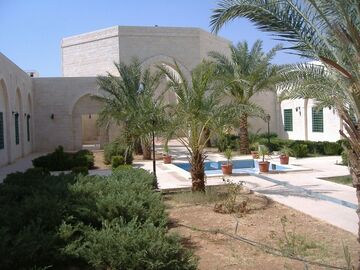
- Abu Ubaidah bin Al-Jarrah (invaded several regions of Al-Sham such as Baalbek, Al-Labwah, and set his foot in Marj Al-Silsilah).

- Abu Huraira (in Marj al-Silsilah).
- Al-Hajjaj bin Abdullah Al-Thumali (was mentioned on the authority of Sufyan bin Mujib Al-Azdi, and the people of Lebanon narrated about him).[47]
- Al-Sa'ib bin Yazid[ar] (Invaded Marj Al-Silsilah).
- Al-Dahhak bin Qais bin Khalid (Abu Bakr joined him with the conquests of al-Sham with Yazid bin Abi Sufyan).
- Anas bin Malik, last major companion of the Prophet to die (stayed in Marj al-Silsilah).
- Busr bin Artah (the owner of the ships in Dhāt al-Ṣawārī, he invaded the sea repeatedly).
- Tha'laba bin Obaid (husband of the sister of Jabal; Al-Sa'abah,[48] Baalbek).
- Hasib bin Saad Al-Ta'i Al-Yamani[ar] (Baalbek).
- Habib bin Maslama al-Fihri (Baalbek).
- Khaled bin Al-Walid (Beqaa, Baalbek, Marj Al-Silsila, Tripoli and Wadi Khaled).
- Rafi' bin Abi Rafi' al-Ta'i, and it is said that he is the son of Umairah.
- Rabia bin Amer bin Bijad (participated in the conquest of Baalbek).
- Saeed bin Zaid (one of the ten to whom Paradise was promised) (Participated in the invasion of Baalbek and Damascus).
- Said ibn Amir Al-Jumahi (Participated in the conquest of Baalbek).
- Sufyan bin Mujib Al-Azdi (Second conqueror of Tripoli, founder of its castle and ruler of Baalbek).
- Salman Al Farsi (stayed in Beirut).
- Sahl bin Saad Al-Saadi (participated in the invasion of Marj Al-Silsilah).Shrine of Shurahbil ibn Hasana, Jordan
- Sharhabil ibn Hasana (conqueror of Tyre, stayed in Tripoli, and was buried in Sidon).
- Safwan bin Al-Mu'attal (Participated in the invasion of Baalbek).
- Dhiraar ibn al-Azwar al-Asadi (invaded Baalbek and Marj al-Silsilah, he killed a Patriarch).
- 'Amer bin Rabī'ah (conquered Marj Al-Silsilah).
- Ubadah ibn al-Samit.
- Abd al-Rahman ibn Abi Bakr al-Siddiq (Baalbek).
- Abd al-Rahman ibn Udays al-Balawi (killed near Baalbek).
- Abdullah bin Abi Awfa (occupied Marj al-Silsilah).
- Abdullah bin Unais (the conqueror of Marj al-Silsilah).
- Abdullah bin Busr Al-Mazini (invaded Marj Al-Silsilah).
- Abdullah bin Tha'labah bin Sa'ir (invaded Marj al-Silsilah).
- Abdullah bin Jaafar Al-Tayyar (invaded Marj Al-Silsila and Al-Beddewi).
- Abdullah bin Qurt Al-Thamali Al-Azdi (Baalbek).
- Abdullah bin Masoud (stayed in Marj al-Silsilah for 3 days).
- Utbah bin Abd: Abu Al-Walid Al-Salami (conquered Al-Silsilah).
- Ata bin Omar Al-Khathami; military advisor, (Baalbek).

- Umar Ibn Al-Khattab (He came to the Levant in the year 17 AH/638 AD).
- Amr bin Maadi Karb (Baalbek).
- Fadala ibn Ubayd (conquered Cyprus by sea and took over the district of Damascus).
- Qanan bin Darem al-Absi (Western Bekaa, Baalbek, and besieged Harbīs in the village).

- Muadh bin Jabal (at the forefront of the sieges of Baalbek).
- Muawiyah bin Abi Sufyan (recorded the Quran by writing) (invaded Beirut, coastal cities, Cyprus and several islands).
- Muammar bin Reab (Baalbek, he testified to its peace treaty).
- Milhan bin Ziyad Al-Taii (the western Bekaa and the siege of Baalbek).
- Maysara bin Masrouq Al-Absi (Baalbek).
- Wathila bin Al-Asqa (from the people of the Suffah) (invaded Marj Al-Silsilah).
- Wahshi bin Harb (Baalbek).
- Yasser bin Ammar bin Salama (Tyre).
- Yazid bin Abi Sufyan (brother of Muawiyah, conquered Baalbek, Beirut, Jbeil, Sidon and Tyre).[49]
. . . . . . . . . . . . . . . . . . . . . . . . . . . . . . . . . . . . . . . . . . . . . . . . . . . . . . . . . . . . . . . . . . . . . . . . . . . . . . . . . . . . . . . . . . . . . . . . . . . . . . . . . . . . . . . . . . . . . . . . . . . . . . . . . . . . . . . . . . . . . . . . . . . . . . . . . . . . . . . . . . . . . . . .
Ṣaḥābiyyat (female companions)

- Al-Sa'ba Bint Jabal (Sister of Mu'adh): Her grave is in Baalbek.
- Umm Al-Hakam bint Abi Sufyan (Sister of Muawiyah, she visited Lebanon by sea to Cyprus.)
- Umm Haram bint Milhan Al-Ansariah (Ubadah's wife).
- Hafsa bint Umayyah bin Harb (cousin of Muawiyah, wife of Sufyan the Conqueror of Tripoli): Tripoli.
- Fakhita bint Qarza (wife of Muawiyah, visited Lebanon by sea to Cyprus).
- Fatima bint Ghashem: She was buried in Baalbek.[49]
العمارة
- Al-Omari Grand Mosque, (ٱلْمَسْجِد ٱلْعُمَرِيّ ٱلْكَبِير) 635 AD, built during the reign of Islam's second Caliph Umar Bin El Khattab.[50][51]
- The Monastery of Mar Yuhanna Maroun, Kfarhay, built in 676 AD by Patriarch John Maron who moved over the relics of the head of Maron into it making the Monastery the first Seat of the Maronite Patriarchate.[52]
انظر أيضاً
ملاحظات
المراجع
- ^ Eutychius (1896). Eucherius about certain holy places: The library of the Palestine Pilgrims' Text Society. Committee of the Palestine Exploration Fund in London. Retrieved 28 January 2015.
- ^ Kaufmann Kohler; A. Rhine (1906). Jewish Encyclopedia CHOSROES (KHOSRU) II. PARWIZ ("The Conqueror"). Jewish Encyclopedia. Retrieved 20 January 2014.
- ^ Elli Kohen (2007). History of the Byzantine Jews: A Microcosmos in the Thousand Year Empire. University Press of America. ISBN 978-0-7618-3623-0. Retrieved 28 January 2015.
- ^ Melvin E. Page; Penny M. Sonnenburg (2003). Colonialism: an international social, cultural, and political encyclopedia. ABC-CLIO. OCLC 773516651.
- ^ Giftopoulou, Sofia (2005). "Diocese of Oriens (Byzantium)". Encyclopaedia of the Hellenic World, Asia Minor. Foundation of the Hellenic World. Archived from the original on 10 June 2015. Retrieved 14 November 2013.
- ^ قال صاحب معجم البلدان 1/38; «وأما الجند فيجيء في قولهم: جند قنسرين، وجند فلسطين، وجند حمص، وجند دمشق، وجند الأردن. فهي خمسة أجناد، وكلها بالشام. ولم يبلغني أنهم استعملوا ذلك في غير أرض الشام
- ^ The History of Baalbek, Hassan Abbas Nasrallah, first edition, volume 1, p. 80 and 81.
- ^ "معالم عربية ... خان المير يدخل خارطة صيدا الثقافية | صحيفة الخليج". 2021-06-07. Archived from the original on 2021-06-07. Retrieved 2022-09-16.
- ^ تاريخ بعلبك، نصر الله، مؤسسة الوفاء، طبعة أولى، مجلد1، ص 96 و 97
- ^ تاريخ بعلبك، نصر الله، مؤسسة الوفاء، طبعة أولى، مجلد1، ص 98
- ^ الواقدي، فتوح الشام، ما بعد ص 419.
- ^ عمر تدمري، الصحابة في لبنان، ص 60.
- ^ البلاذُري، فتوح البلدان، من ص126 إلى 128، مكتبة مشكاة الإسلامية.
- ^ السيد محسن الامين : خطط جبل عامل ، ص 65-66
- ^ Abdul-Rahman, Muhammad N. The Study of 'Abbasid History in the Arab World (دراسات التاريخ العباسي في العالم العربي).
- ^ الموارنة وروما
- ^ Stratos, Andreas N. (1978). Byzantium in the seventh century. Hakkert. OCLC 271034068.
- ^ Le Strange 1890, pp. 32–35, 39.
- ^ عمر تدمري، لبنان من الفتح الإسلامي حتى سقوط الدولة الأموية، ص 218، طرابلس، جروس برس، ط1/1410هـ - 1990م.
- ^ Geoffrey Greatrex; Samuel N. C. Lieu (2008). The Roman eastern frontier and the Persian Wars. a narrative sourcebook. Routledge. ISBN 978-0-415-46530-4. OCLC 192080457.
- ^ أ ب El-Hāyek, Elias. "Struggle for Survival: The Maronites of the Middle Ages", Conversion and Continuity, (Michael Gervers and Ramzi Jibran Bikhazi, eds.), Pontifical Institute of Mediaeval Studies, 1990
- ^ J. D. Frendo, "Who killed Anastasius II?" Jewish Quarterly Review vol. 72 (1982), 202-4
- ^ Neusner, Jacob. a history of the jews in babylonia v. later sasanian times (in الإنجليزية). Brill Archive.
- ^ "Life of St. John Maron", St John Maron Catholic Church Maronite Rite
- ^ Norwich, John Julius (2013). A short history of Byzantium. Penguin. ISBN 978-0-241-95305-1. OCLC 818450253.
- ^ أ ب "المارونية". www.saaid.net. Retrieved 2022-08-11.
- ^ أ ب ت "الجدول الزمني لتاريخ لبنان". areq.net. Retrieved 2022-08-11.
- ^ Harris, William W. (2012). Lebanon: a history, 600-2011. Oxford University Press. ISBN 978-0-19-518112-8. OCLC 757935847.
- ^ تاريخ بعلبك، حسن عباس نصر الله، طبعة أولى، مجلد 1، ص 80 و 81.
- ^ Tibbetts, Jann (2016). 50 Great Military Leaders of All Time. New Delhi: Vij Books India Private Limited. ISBN 978-93-85505-66-9. OCLC 974593317.
- ^ Britannica 1910
- ^ تاريخ بعلبك، نصر الله، مؤسسة الوفاء، طبعة أولى، مجلد1، صفحة 81: 83
- ^ (Firm), Lonely Planet Publications. Syria & Lebanon. Lonely Planet Publications. OCLC 671807903.
- ^ Joseph S. Brusher, Popes through the Ages, (Neff-Kane, 1980), 174.
- ^ Milman, Henry Hart (1872). Históry of Latin Christianity Including that of the Popes to the Pontificate of Médas V, 2. Murray.
- ^ Maronite Chronicle
- ^ Al-Muhajir, Jaafar (1992). The Foundation of the History of the Shiites in Lebanon and Syria: The First Scholarly Study on the History of Shiites in the Region (in Arabic). Beirut: Dar al-Malak.
{{cite book}}: CS1 maint: unrecognized language (link) - ^ Andrew Palmer; Sebastian P. Brock; Robert Hoyland; Robert G. Hoyland, eds. (1993). The seventh century in the West-Syrian chronicles. Liverpool [England]: Liverpool University Press. ISBN 0-85323-238-5. OCLC 42719747.
- ^ Mann, Horace Kinder (1908). . Catholic Encyclopedia. Vol. 4.
- ^ Chronographie of Theophanes the Confessor
- ^ Lilie, Ralph-Johannes (1976). Die byzantinische Reaktion auf die Ausbreitung der Araber. Studien zur Strukturwandlung des byzantinischen Staates im 7. und 8. Jhd (in German). Munich: Institut für Byzantinistik und Neugriechische Philologie der Universität München. OCLC 797598069.
- ^ Bury, J.B., A History of the Later Roman Empire from Arcadius to Irene, Vol. II, MacMillan & Co., 1889, p. 321
- ^ Canard, Marius (1965). "Ḏj̲arād̲j̲ima". In Lewis, B.; Pellat, Ch. & Schacht, J. (eds.). The Encyclopaedia of Islam, New Edition, Volume II: C–G. Leiden: E. J. Brill. p. 457. OCLC 495469475.
- ^ Palmer, p. 29.
- ^ "The Origins of the Maronites: People, Church, Doctrine"
- ^ Al-Duwayhi, Tarīkh, pg. 91
- ^ "الحجاج بن عبد الثمالي - The Hadith Transmitters Encyclopedia". hadithtransmitters.hawramani.com. Retrieved 2022-08-15.
- ^ https://sahaba.rasoolona.com/Sahaby/26071/ما-ذكر-عنها-في-الإصابة-في-تميز-الصحابة/الصعبة-بنت-جبل-بن-عمرو-بن-أوس
- ^ أ ب الصحابة في لبنان - أ.د. عمر عبد السلام تدمري
- ^ الوالي، الشّيخ محمد طه (1973) تأريخ المساجد والجوامع الشريفة في بيروت، دار الكتب، بيروت.
- ^ Enlart, Camille (1904) "La Cathédrale Saint-Jean de Beyrouth" in: Société Nationale des Antiquaires de France: centenaire 1804-1904, Klincksieck, Paris: 121-133.
- ^ "The monastery of Mar Youhana Maroun, Kfarhay – LebanonUntravelled.com" (in الإنجليزية الأمريكية). Retrieved 2022-08-26.
المصادر
- Le Strange, Guy (1890). Palestine Under the Moslems: A Description of Syria and the Holy Land from A.D. 650 to 1500. Translated from the Works of the Medieval Arab Geographers (in الإنجليزية). Houghton, Mifflin.

